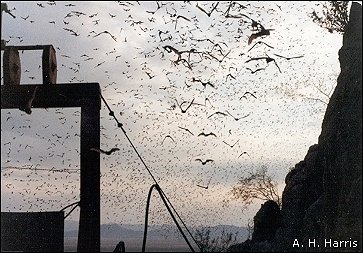
Some species of bats emerge from their daytime roosts in such numbers as to virtually form a living stream. Some owls have learned to take advantage of the dense concentrations, hurling themselves pell-mell into the emerging column, talons clutching spasmodically in hopes of impaling one of the flitterers. Such is the density that apparently success is frequent enough to make the effort worthwhile.
Investigation into the diet of the Western Spotted Owl, though, seems to reveal a far more agile bird. Several kinds of bats were identified in a relatively small sample of owl pellets. What is different from the scenario just noted is that several of the kinds are basically solitary bats that presumably had to be hunted down, one on one. If you've ever watched the seemingly erratic, but highly sophisticated, flight of bats, you'll have to admire any bird that can bring one down on the wing. Bat catching not good enough for you? In the same batch of owl pellets lay the remains of a bird whose common name says it all: a swift!

Contributor: Arthur H. Harris, Laboratory for Environmental Biology, Centennial Museum, University of Texas at El Paso.
Desert Diary is a joint production of the Centennial Museum and KTEP National Public Radio at the University of Texas at El Paso.

Mexican Free-tailed Bats (Tadarida brasiliensis) leaving their cave roost, thick enough to entice owls. Photograph by A.H. Harris.